商务英语阅读第二版 王关富 Unit 6 Goodbye Free Trade 课后答案
- 格式:doc
- 大小:39.34 KB
- 文档页数:14
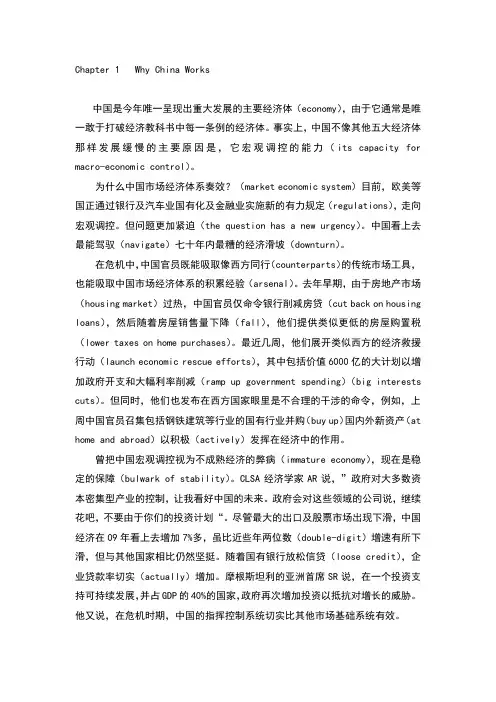
Chapter 1 Why China Works中国是今年唯一呈现出重大发展的主要经济体(economy),由于它通常是唯一敢于打破经济教科书中每一条例的经济体。
事实上,中国不像其他五大经济体那样发展缓慢的主要原因是,它宏观调控的能力(its capacity for macro-economic control)。
为什么中国市场经济体系奏效?(market economic system)目前,欧美等国正通过银行及汽车业国有化及金融业实施新的有力规定(regulations),走向宏观调控。
但问题更加紧迫(the question has a new urgency)。
中国看上去最能驾驭(navigate)七十年内最糟的经济滑坡(downturn)。
在危机中,中国官员既能吸取像西方同行(counterparts)的传统市场工具,也能吸取中国市场经济体系的积累经验(arsenal)。
去年早期,由于房地产市场(housing market)过热,中国官员仅命令银行削减房贷(cut back on housing loans),然后随着房屋销售量下降(fall),他们提供类似更低的房屋购置税(lower taxes on home purchases)。
最近几周,他们展开类似西方的经济救援行动(launch economic rescue efforts),其中包括价值6000亿的大计划以增加政府开支和大幅利率削减(ramp up government spending)(big interests cuts)。
但同时,他们也发布在西方国家眼里是不合理的干涉的命令,例如,上周中国官员召集包括钢铁建筑等行业的国有行业并购(buy up)国内外新资产(at home and abroad)以积极(actively)发挥在经济中的作用。
曾把中国宏观调控视为不成熟经济的弊病(immature economy),现在是稳定的保障(bulwark of stability)。
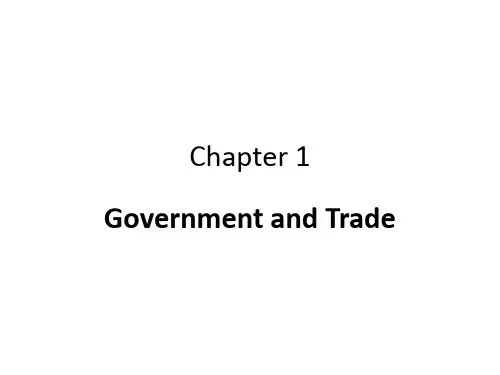
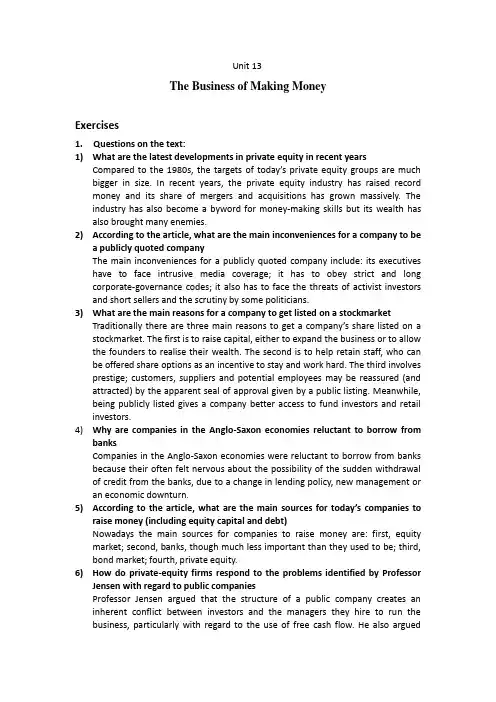
Unit 13The Business of Making MoneyExercises1. Questions on the text:1)What are the latest developments in private equity in recent yearsCompared to the 1980s, the targets of today’s private equity groups are much bigger in size. In recent years, the private equity industry has raised record money and its share of mergers and acquisitions has grown massively. The industry has also become a byword for money-making skills but its wealth has also brought many enemies.2)According to the article, what are the main inconveniences for a company to bea publicly quoted companyThe main inconveniences for a publicly quoted company include: its executives have to face intrusive media coverage; it has to obey strict and long corporate-governance codes; it also has to face the threats of activist investors and short sellers and the scrutiny by some politicians.3)What are the main reasons for a company to get listed on a stockmarketTraditionally there are three main reasons to get a company’s share listed on a stockmarket. The first is to raise capital, either to expand the business or to allow the founders to realise their wealth. The second is to help retain staff, who can be offered share options as an incentive to stay and work hard. The third involves prestige; customers, suppliers and potential employees may be reassured (and attracted) by the apparent seal of approval given by a public listing. Meanwhile, being publicly listed gives a company better access to fund investors and retail investors.4)Why are companies in the Anglo-Saxon economies reluctant to borrow frombanksCompanies in the Anglo-Saxon economies were reluctant to borrow from banks because their often felt nervous about the possibility of the sudden withdrawal of credit from the banks, due to a change in lending policy, new management or an economic downturn.5)According to the article, what are the main sources for today’s companies toraise money (including equity capital and debt)Nowadays the main sources for companies to raise money are: first, equity market; second, banks, though much less important than they used to be; third, bond market; fourth, private equity.6)How do private-equity firms respond to the problems identified by ProfessorJensen with regard to public companiesProfessor Jensen argued that the structure of a public company creates an inherent conflict between investors and the managers they hire to run the business, particularly with regard to the use of free cash flow. He also arguedthat borrowing imposed discipline on executives. Private-equity firms have applied his argument in practice by gearing up the balance sheets of companies they buy with more debt than public firms are willing to accept. Though private equity firms, in the process, often have a bad reputation for relentlessly cutting unprofitable operations and shedding jobs, academic studies suggest that they create jobs rather than destroy them.7)What are the similarities and differences between today’s private-equity firmsand the conglomerates of the 1970s and 1980sSimilarities between today’s private-equity firms and the conglomerates of the 1970s and 1980s are: first, both of them use their financial power to construct diverse industrial empires; second, both claim that they could improve the companies they owned through superior management. The differences are: first, the conglomerates used highly rated shares to buy companies while private-equity firms use borrowed money; second, the conglomerates used to make ever-bigger acquisitions continuously to expand while private-equity firms claim to sell regularly their portfolio companies or business for profit.8)What make it impossible for the private-equity model to become the norm forcompaniesThere are several reasons: first, what might be logical for an individual company might not be best for the economy overall. If all companies were to substitute debt for equity on the scale that private-equity firms have, there would be an increase in the cost of debt. That would lead to lower equity returns; second, since private-equity firms need an exit route to sell their investments, a public market will be needed in the end for someone to realise their profit; third, a bigger role for private equity might make the economy more vulnerable because in a world where most companies carried private-equity-style debt levels, companies would be much more vulnerable and recessions might become much more frequent and consequently monetary policy would become more difficult, and even government revenues might be affected.9)According to the article, what factors have helped the development ofprivate-equity firms since 2003Those factors are: low interest rates, lots of liquidity and rising asset prices10)What are the signs showing that private-equity firms may now face the peak ofthe cycleThose signs are: first, bond yields have been rising, making takeovers more expensive; second, the high level of corporate profits suggests that it could be difficult for private-equity firms to wring more money out of these companies;third, the relentless campaign against private-equity tax privileges may lead to government actions against the interests of private-equity firms; last, more and more private-equity deals often leads to more competition and thus lower returns.2. Fill in each blank of the following sentences with one of the phrases in the list given below:1)The journey usually takes six weeks but you should allow for delays caused bybad weather.2) A popular bicycle rental scheme in Paris that has transformed travel in the cityhas run into problems just 18 months after its successful launch.3)China’s import as a proportion of total trade has substantially increased inrecent years as it’s been pursuing a more balanced trade.4) A growing pile of evidence shows that skimping on sleep promotes weight gain.5)Such a move would put the bank in danger of going bust.6)We have turned down four applicants already.7)When you're cooking, you should keep all the ingredients close at hand.8)She wrote to him in the belief that he would help her.9)Dr. Cong will continue to lead the company as its CEO and hold a stake in it forthree years.10)A lot of questions were being asked at the conference today and surprisingly theofficials answered them in spades.11)In the absence of outside leadership, we have created these guidelines in orderto respond timely and effectively.12)With the joining of South Africa, the Bric club of influential emerging economiesis now in pursuit of a common market among them.3. Match the terms in column A with the explanations in column B:A B1) corporate governance a) An investor who attempts to force a corporation tomake changes in management, board structure,investment policies, use of retained earnings, orother practices, often by introducing shareholderproposals or putting forward alternative directors.62) bridge financing b) An interest group that endeavors to influencepublic policy and especially governmentallegislation, regarding its particular concerns andpriorities. 83) trade union c) A privilege, sold by one party to another, thatgives the buyer the right, but not the obligation, tobuy or sell a stock at an agreed-upon price withinacertain period or on a specific date. 104) stakeholder d) A method of financing, used by companies beforetheir IPO, to obtain necessary cash for themaintenance of operations. 25) short seller e) The set of processes, customs, policies, laws, andinstitutions affecting the way a corporation (orcompany) is directed, administered or controlled.16) activist investor f) A n organization of workers that have bandedtogether to achieve common goals such as higherwages or better working conditions. 37) venture capital g) The process of buying an undervalued companywith the intent to sell off its assets for a profit. 9 8) pressure group h) An investor who sells a commodity, currency, orsecurity which he or she does not own at the timeof sale. 59) asset stripping i) Money provided by investors to startup firms andsmall businesses with perceived long-term growthpotential. 710) stock option j) Person, group, or organization that has direct orindirect stake in an organization because it canaffect or be affected by the organization's actions,objectives, and policies. 44.Translate the following into Chinese:出于几个原因,上市的前景对私募股权投资公司而言具有相当的吸引力。
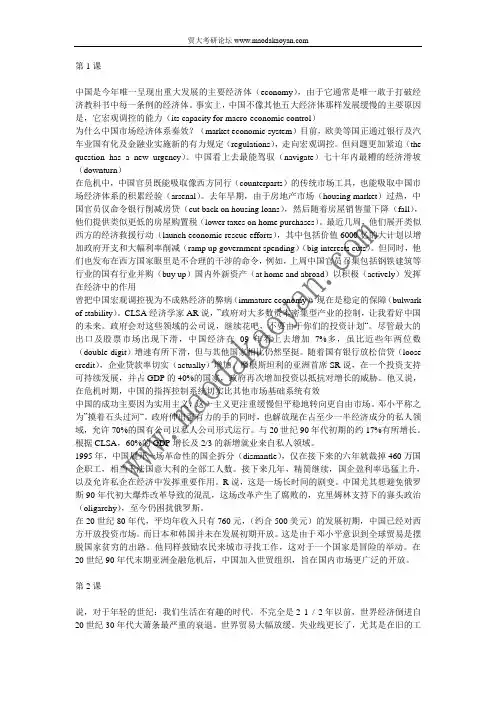
第1课中国是今年唯一呈现出重大发展的主要经济体(economy),由于它通常是唯一敢于打破经济教科书中每一条例的经济体。
事实上,中国不像其他五大经济体那样发展缓慢的主要原因是,它宏观调控的能力(its capacity for macro-economic control)为什么中国市场经济体系奏效?(market economic system)目前,欧美等国正通过银行及汽车业国有化及金融业实施新的有力规定(regulations),走向宏观调控。
但问题更加紧迫(the question has a new urgency)。
中国看上去最能驾驭(navigate)七十年内最糟的经济滑坡(downturn)在危机中,中国官员既能吸取像西方同行(counterparts)的传统市场工具,也能吸取中国市场经济体系的积累经验(arsenal)。
去年早期,由于房地产市场(housing market)过热,中国官员仅命令银行削减房贷(cut back on housing loans),然后随着房屋销售量下降(fall),他们提供类似更低的房屋购置税(lower taxes on home purchases)。
最近几周,他们展开类似西方的经济救援行动(launch economic rescue efforts),其中包括价值6000亿的大计划以增加政府开支和大幅利率削减(ramp up government spending)(big interests cuts)。
但同时,他们也发布在西方国家眼里是不合理的干涉的命令,例如,上周中国官员召集包括钢铁建筑等行业的国有行业并购(buy up)国内外新资产(at home and abroad)以积极(actively)发挥在经济中的作用曾把中国宏观调控视为不成熟经济的弊病(immature economy),现在是稳定的保障(bulwark of stability)。
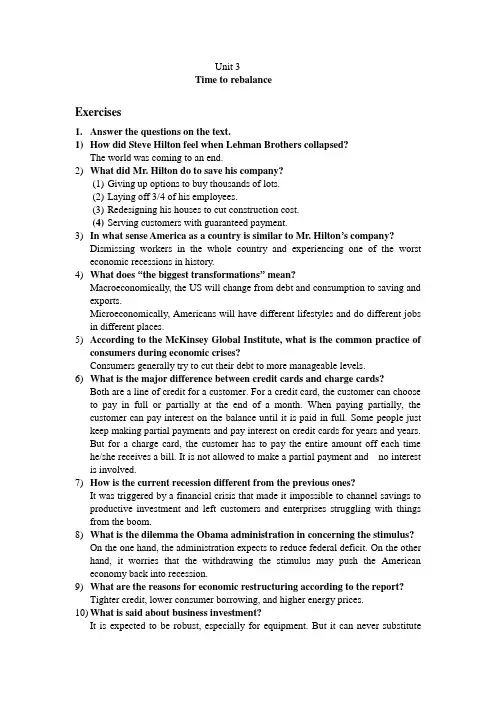
Unit 3Time to rebalanceExercises1.Answer the questions on the text.1)How did Steve Hilton feel when Lehman Brothers collapsed?The world was coming to an end.2)What did Mr. Hilton do to save his company?(1)Giving up options to buy thousands of lots.(2)Laying off 3/4 of his employees.(3)Redesigning his houses to cut construction cost.(4)Serving customers with guaranteed payment.3)In what sense America as a country is similar to Mr. Hilton’s company?Dismissing workers in the whole country and experiencing one of the worst economic recessions in history.4)What does “the biggest transformations” mean?Macroeconomically, the US will change from debt and consumption to saving and exports.Microeconomically, Americans will have different lifestyles and do different jobs in different places.5)According to the McKinsey Global Institute, what is the common practice ofconsumers during economic crises?Consumers generally try to cut their debt to more manageable levels.6)What is the major difference between credit cards and charge cards?Both are a line of credit for a customer. For a credit card, the customer can choose to pay in full or partially at the end of a month. When paying partially, the customer can pay interest on the balance until it is paid in full. Some people just keep making partial payments and pay interest on credit cards for years and years.But for a charge card, the customer has to pay the entire amount off each time he/she receives a bill. It is not allowed to make a partial payment and no interest is involved.7)How is the current recession different from the previous ones?It was triggered by a financial crisis that made it impossible to channel savings to productive investment and left customers and enterprises struggling with things from the boom.8)What is the dilemma the Obama administration in concerning the stimulus?On the one hand, the administration expects to reduce federal deficit. On the other hand, it worries that the withdrawing the stimulus may push the American economy back into recession.9)What are the reasons for economic restructuring according to the report?Tighter credit, lower consumer borrowing, and higher energy prices.10)What is said about business investment?It is expected to be robust, especially for equipment. But it can never substituteconsumer spending.11)What changes have occurred in the United States in terms of consumption?(1)American consumers spend less but save more.(2)American companies thus look to an export boom abroad.(3)The US has changed from a consuming nation to an exporting economy,accounting for only 27% of global consumption this year, much less than that of emerging markets.12)What makes the report optimistic about the American economy?(1)The US has been increasing exports abroad, particularly emerging markets.(2)America’s current-account deficit dropped from 6% to 3%.(3)American firms are busy preparing for their investment.2.Fill in each blank of the following sentences with one of the phrases in the listgiven below. Make changes when necessary.1)Investors from big cities are quick to snap up real estates in this booming townfor their rising future values.2)There are already clear signals that the investors will shift away from thefinancial firm in legal trouble.3)High input costs are likely to put pressure on steel prices in the domestic marketeven if demand still remains high.4)The prime minister said Thursday that a new international airport will be built inthe southern city to cater to the rising number of passengers and air cargoes there.5)Many economists fear that the contraction of money supply may dry up financingneeded for various economic activities.6)Professor Nil was, however, quick to warn the public to be on their guard againstthose counterfeits already in circulation.7)Academy Awards, Emmy Awards and dozens of prestigious awards fromprominent film festivals around the world attest to the stellar quality of the films being featured at the annual World Community Film Festival.8) A neighborhood group in the district plans to hold a fundraiser to help childrenpay off overdue book fines so that they can resume using their library.9)The writer’s fame shrank last year because the public thought he was knockingout so many things.10)Business leaders have urged the government to snap up farmland overseas togrow basic staples as a buffer against soaring food prices.11)The Vancouver team vowed to get back to doing the little things right and knew itwould add up to big things.12)What has happened over the past few years indicates that great political, socialand economic transformations are in the making.3.Match the terms in column A with the definitions in column B.A_______________________ B________________________________________1)emerging market A) A contract that permits the owner, depending onthe type of option held, to purchase or sell anasset at a fixed price until a specific date.62)profit margin B) A theoretical construct that represents economicprocesses by a set of variables and a set of logicaland quantitative relationships between them.10 3)consumer spending C) An economy, with fast growth rate but low tomiddle per capita income, has opened up itsmarket and integrated itself into the globaleconomy.14)consumerism D) The process of moving from a period of lossesor low profitability into a more profitable stagefor a firm, industry or economy.85)disposable income E) Ratio of profit after taxes to cost-of-sales, oftenexpressed as a percentage, measuring theprofitability of a firm and indicating its coststructure.26)option F) Portion of the balance of payments consistingof exports and imports of goods and services, aswell as transfer payments such as foreign aidgrants. 97)economic restructuring G) The amount of money spent by households,measured monthly, making up an important partof an economy.38)turnaround H) The phenomenon of an economy shifting froma manufacturing to a service sector economicbase. 79)current account I) A movement equating personal happiness withpurchasing material possessions andconsumption. 410)economic model J) The amount of income left to an individualafter taxes have been paid, available forspending and saving. 54.Translate the following passage into Chinese:目前石油价格飞涨,接近110美元一桶,食品和其他货物的成本也随之上涨。
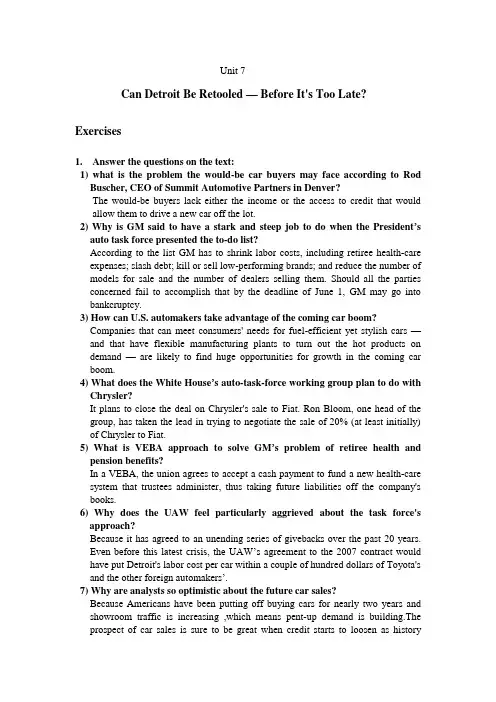
Unit 7Can Detroit Be Retooled — Before It's Too Late? Exercises1. Answer the questions on the text:1) what is the problem the would-be car buyers may face according to RodBuscher, CEO of Summit Automotive Partners in Denver?The would-be buyers lack either the income or the access to credit that would allow them to drive a new car off the lot.2) Why is GM said to have a stark and steep job to do when the President’sauto task force presented the to-do list?According to the list GM has to shrink labor costs, including retiree health-care expenses; slash debt; kill or sell low-performing brands; and reduce the number of models for sale and the number of dealers selling them. Should all the parties concerned fail to accomplish that by the deadline of June 1, GM may go into bankcruptcy.3) How can U.S. automakers take advantage of the coming car boom?Companies that can meet consumers' needs for fuel-efficient yet stylish cars —and that have flexible manufacturing plants to turn out the hot products on demand —are likely to find huge opportunities for growth in the coming car boom.4) What does the White House’s auto-task-force working group plan to do withChrysler?It plans to close the deal on Chrysler's sale to Fiat. Ron Bloom, one head of the group, has taken the lead in trying to negotiate the sale of 20% (at least initially) of Chrysler to Fiat.5) What is VEBA approach to solve GM’s problem of retiree health andpension benefits?In a VEBA, the union agrees to accept a cash payment to fund a new health-care system that trustees administer, thus taking future liabilities off the company's books.6) Why does the UAW feel particularly aggrieved about the task force'sapproach?Because it has agreed to an unending series of givebacks over the past 20 years.Even before this latest crisis, the UAW’s agreement to the 2007 contract would have put Detroit's labor cost per car within a couple of hundred dollars of Toyota's and the other foreign automakers’.7) Why are analysts so optimistic about the future car sales?Because Americans have been putting off buying cars for nearly two years and showroom traffic is increasing ,which means pent-up demand is building.The prospect of car sales is sure to be great when credit starts to loosen as historyindicates.8) What are the elements that make analysts believe North American demandfor cars will approach 16 million units within five years from the year 2009?The elements include the replacement demand, scrappage rates, demographic changes and an economic recovery.9) What are the competitive GM brands mentened in the passage?They are award-winning Chevy Malibu and the 2009 Buick LaCrosse, which recently topped all midsize competitors in dependability ratings.10) What competition will the US car industry face in the near future?The US car industry will have to win millions of buyers’ recognition for theirbrands, and try to play better in the competition with companies in Asia, such as China's Chery Automobile and India's Tata Motors, as well as the established players like Volkswagen and Hyundai-Kia.2. Fill in each blank of the following sentences with one of the phrases in the listgiven below:1) With his expanding wireless broadband plan, Obama wants to usher everyAmerican into the 'Digital Age'.2) School activities start winding down about two weeks before the end ofsemester.3) The man said he couldn't come up with an appropriate answer just at the time.4) Everybody is sure that the ceaseless dripping of water will in the end hollow outa stone.5) The progressive movement, which had already brought important changes infederal policies, stood on the verge of culmination and fulfillment6) The state has suffered so much loss. The smugglers should never be allowed toget off easy.7) After production expansion, this company now can turn out a million televisionsets a month.8) The preeminent writer's personal appearance picked up the sales of the bookconsiderably9) The newly announced credit policy may help many family-owned businesses getthrough the tough times at present..10) The government has imposed drastic economic controls to choke off inflation.11) To execute full-cost accounting, companies must account for the true cost of theirproducts.12) Economists are not so optimistic because there is no sign that the recession hasbottomed out.3. Match the terms in column A with the explanations in column B:A B1) bondholder a) A measure of a company's financial health,whichequals cash receipts minus cash payments over agiven period of time. 62) creditor b) A financial asset whose value has fallensignificantly and which fails generate cashflowand is worth much less than expected. 73) dealership c) An entity (person or institution) that extendscredit by giving another entity permission toborrow money if it is paid back at a later date. 2 4) health-care expenses d) A unit specially organized to work on a singledefined task 105) manufacturing capacity e) A business company that is owned or controlledby another larger company 96) net cash flow f) A person owning a bond or bonds issued by agovernment or a public company 17) bad asset g) Money used for the preservation of mental andphysical health by preventing or treating illnessthrough services offered by the healthprofession 48) hot products h) Volume of products or services that can begenerated by a production plant or enterprise ina given period by using current resources. 59) subsidiary# i) A business established or operated under anauthorization to sell or distribute a company’sgoods or service in a particular area 310) task force j) Products that are extremely populous amongconsumers and normally sell like hot cakes inthe market. 84.Translate the following into Chinese:凭借这股势头,现代集团正加快从生产线上推出新车型的速度。
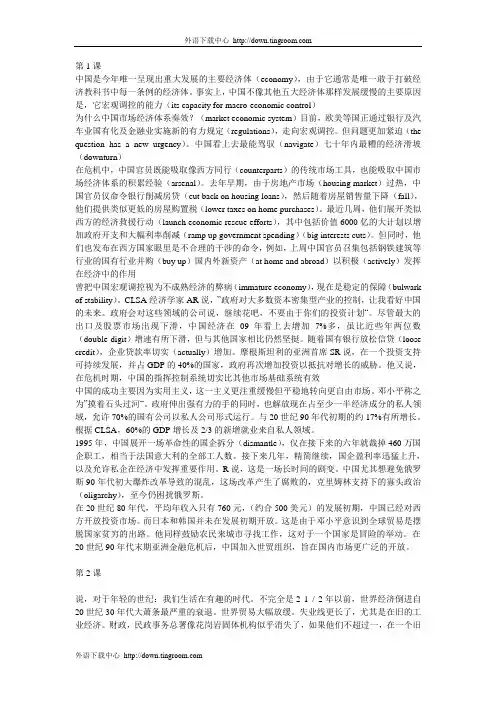
第1课中国是今年唯一呈现出重大发展的主要经济体(economy),由于它通常是唯一敢于打破经济教科书中每一条例的经济体。
事实上,中国不像其他五大经济体那样发展缓慢的主要原因是,它宏观调控的能力(its capacity for macro-economic control)为什么中国市场经济体系奏效?(market economic system)目前,欧美等国正通过银行及汽车业国有化及金融业实施新的有力规定(regulations),走向宏观调控。
但问题更加紧迫(the question has a new urgency)。
中国看上去最能驾驭(navigate)七十年内最糟的经济滑坡(downturn)在危机中,中国官员既能吸取像西方同行(counterparts)的传统市场工具,也能吸取中国市场经济体系的积累经验(arsenal)。
去年早期,由于房地产市场(housing market)过热,中国官员仅命令银行削减房贷(cut back on housing loans),然后随着房屋销售量下降(fall),他们提供类似更低的房屋购置税(lower taxes on home purchases)。
最近几周,他们展开类似西方的经济救援行动(launch economic rescue efforts),其中包括价值6000亿的大计划以增加政府开支和大幅利率削减(ramp up government spending)(big interests cuts)。
但同时,他们也发布在西方国家眼里是不合理的干涉的命令,例如,上周中国官员召集包括钢铁建筑等行业的国有行业并购(buy up)国内外新资产(at home and abroad)以积极(actively)发挥在经济中的作用曾把中国宏观调控视为不成熟经济的弊病(immature economy),现在是稳定的保障(bulwark of stability)。
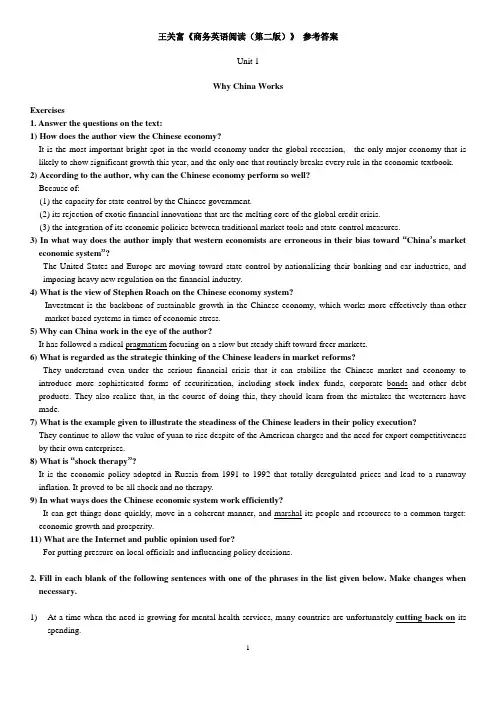
王关富《商务英语阅读(第二版)》参考答案Unit 1Why China WorksExercises1. Answer the questions on the text:1) How does the author view the Chinese economy?It is the most important bright spot in the world economy under the global recession, the only major economy that is likely to show significant growth this year, and the only one that routinely breaks every rule in the economic textbook. 2) According to the author, why can the Chinese economy perform so well?Because of:(1) the capacity for state control by the Chinese government.(2) its rejection of exotic financial innovations that are the melting core of the global credit crisis.(3) the integration of its economic policies between traditional market tools and state control measures.3) In what way does the author imply that western economists are erroneous in their bias toward “China’s market economic system”?The United States and Europe are moving toward state control by nationalizing their banking and car industries, and imposing heavy new regulation on the financial industry.4) What is the view of Stephen Roach on the Chinese economy system?Investment is the backbone of sustainable growth in the Chinese economy, which works more effectively than other market based systems in times of economic stress.5) Why can China work in the eye of the author?It has followed a radical pragmatism focusing on a slow but steady shift toward freer markets.6) What is regarded as the strategic thinking of the Chinese leaders in market reforms?They understand even under the serious financial crisis that it can stabilize the Chinese market and economy to introduce more sophisticated forms of securitization, including stock index funds, corporate bonds and other debt products. They also realize that, in the course of doing this, they should learn from the mistakes the westerners have made.7) What is the example given to illustrate the steadiness of the Chinese leaders in their policy execution?They continue to allow the value of yuan to rise despite of the American charges and the need for export competitiveness by their own enterprises.8) What is “shock therapy”?It is the economic policy adopted in Russia from 1991 to 1992 that totally deregulated prices and lead to a runaway inflation. It proved to be all shock and no therapy.9) In what ways does the Chinese economic system work efficiently?It can get things done quickly, move in a coherent manner, and marshal its people and resources to a common target: economic growth and prosperity.11) What are the Internet and public opinion used for?For putting pressure on local officials and influencing policy decisions.2. Fill in each blank of the following sentences with one of the phrases in the list given below. Make changes when necessary.1)At a time when the need is growing for mental health services, many countries are unfortunately cutting back on itsspending.2)There is an increasing number of people out of work. But the western media often unfairly label them as lazy andreliable.3)Now that the flow of oil has been stopped by BP, the impact of all the spilled oil and natural gas is still beingmeasured.4)Once again its ability to steer economic policy will be tested against the ability to deliver on services and projectsaimed at growing the economy and jobs.5)Housing prices are incredibly high today. But he bought his house for a song about five years ago.6)As people are complaining high prices, especially those related to daily necessities, the government feels rather urgentto hold down inflation rate immediately.7)Under the new economy policy investors are invited to buy into state-owned enterprises.8)Since a serious gun shooting occurred in Arizona last week, security concerns have trickled down to all places,including residential buildings.9)Social unrest is a daily occurrence in the country nowadays. It is in the last place when it comes to investment formultinational companies.10)Efforts to ban smoking in China are so effective yet. Some chain smokers never think of quitting while many othershave battled in vain to quit.3. Match the terms in column A with the definitions in column B:A_______________________ B__________________________________1)financial innovation A) A reduction in the general availability of loans (orcredit) or a sudden tightening of the conditionsrequired to obtain a loan from the banks.72)stimulus package B) A non-bank entity or organization such asinvestment companies and mutual funds thatinvests in large quantities. 83)overheating C)A legal entity created by a government to undertakecommercial activities on its behalf. 64)stamp tax D) The trading of a corporation's stock or othersecurities (e.g. bonds or stock options) byindividuals with potential access to non-publicinformation.9E) An industry that requires large amounts of capital, machinery and equipment toproduce goods. 55)capital-intensive sector F) Generation of new and creative approaches tosecurities, money management or investing. 16)state-run firm G) An economy that is expanding so rapidly that toomuch money is chasing too few goods andeconomists fear a rise in inflation . 37)credit crisis H) tax levied on certain legal transactions such as thetransfer of a property such as building, copyright,land, patent, and securities. 48)institutional investor I) A plan or a series of measures taken by agovernment to jump-start its ailing economy,generally as a part of its fiscal policy. 210) insider trading4. Translate the following passage into Chinese.我们所面临的来自中国的真正挑战并不是他们向我们大量销售的货物,而恰恰相反,是他们正在提升的价值链。
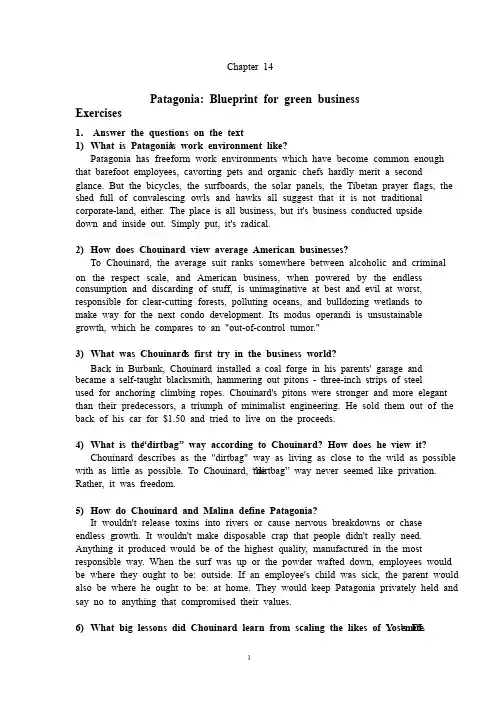
Chapter 14 Patagonia: Blueprint for green business Exercises 1. Answer the questions on the text 1) What is Patagonia ’s work environment like? Patagonia has freeform work environments which have become common enough that that barefoot barefoot barefoot employees, employees, employees, cavorting cavorting cavorting pets pets pets and and and organic organic organic chefs chefs chefs hardly hardly hardly merit merit merit a a a second second glance. But the bicycles, the surfboards, the solar panels, the Tibetan prayer flags, the shed shed full full full of of of convalescing convalescing convalescing owls owls owls and and and hawks hawks hawks all all all suggest suggest suggest that that that it it it is is is not not not traditional traditional corporate-land, corporate-land, either. either. either. The The The place place place is is is all all all business, business, business, but but but it's it's it's business business business conducted conducted conducted upside upside down and inside out. Simply put, it's radical. 2) How does Chouinard view average American businesses? To Chouinard, the average suit ranks somewhere between alcoholic and criminal on the respect scale, and American business, when powered by the endless consumption consumption and and and discarding discarding discarding of of of stuff, stuff, stuff, is is is unimaginative unimaginative unimaginative at at at best best best and and and evil evil evil at at at worst, worst, responsible responsible for for for clear-cutting clear-cutting clear-cutting forests, forests, forests, polluting polluting polluting oceans, oceans, oceans, and and and bulldozing bulldozing bulldozing wetlands wetlands wetlands to to make make way way way for for for the the the next next next condo condo condo development. development. development. Its Its Its modus modus modus operandi operandi operandi is is is unsustainable unsustainable growth, which he compares to an "out-of-control tumor." 3) What was Chouinard ’s first try in the business world? Back Back in in in Burbank, Burbank, Burbank, Chouinard Chouinard Chouinard installed installed installed a a a coal coal coal forge forge forge in in in his his his parents' parents' parents' garage garage garage and and became became a a a self-taught self-taught self-taught blacksmith, blacksmith, blacksmith, hammering hammering hammering out out out pitons pitons pitons - - - three-inch three-inch three-inch strips strips strips of of of steel steel used for anchoring climbing ropes. Chouinard's pitons were stronger and more elegant than their predecessors, a triumph of minimalist engineering. He sold them out of the back of his car for $1.50 and tried to live on the proceeds. 4) What is the “dirtbag dirtbag”” way according to Chouinard? How does he view it? Chouinard describes as the "dirtbag" way as living as close to the wild as possible with as little as possible. To Chouinard, the “dirtbag dirtbag”” way never seemed like privation. Rather, it was freedom. 5) How do Chouinard and Malina define Patagonia? It It wouldn't wouldn't wouldn't release release release toxins toxins toxins into into into rivers rivers rivers or or or cause cause cause nervous nervous nervous breakdowns breakdowns breakdowns or or or chase chase endless endless growth. growth. growth. It It It wouldn't wouldn't wouldn't make make make disposable disposable disposable crap crap crap that that that people people people didn't didn't didn't really really really need. need. Anything Anything it it it produced produced produced would would would be be be of of of the the the highest highest highest quality, quality, quality, manufactured manufactured manufactured in in in the the the most most responsible way. When the surf was up or the powder wafted down, employees would be where they ought to be: outside. If an employee's child was sick, the parent would also be where he ought to be: at home. They would keep Patagonia privately held and say no to anything that compromised their values. 6) What big lessons did Chouinard learn from scaling the likes of Yosemite ’s EL After school Alan always threw himself into computer games. Some of his good luck must have rubbed off on me. We are taught from childhood to distance ourselves from a bad neighbor so as to He was p issedpissed off by the manSusan has an annoying habit of spying on her neighbors. She signed on for a concentrated course in the basics of nursing by the Red Cross. to break intopledges to be in residencewill be Chua's celebration of Chinese parenting and her bizarre assertions fly in the face ofAs a result, durable goods tend to punch above their weight) in determining if The basketball players are suiting up in the locker room. 11) The basketball players 12) Saddled with) ) the A B ___such as bicycling, boating and climbing.2under government ownership. 3the general public can buy its shares. 1business. 8populated. 5efficiency, recycling, and healthy housing. 9a location. 44operations, before deductions for expenses. 7working hours certain limits. 6protected by the patent. 10categories EXCEPT . According to the passage, the CDP is an organization that focuses on . on items like tooth paste and soup Wal-Mart admitted to emit 1.5 million metric tons of carbon dioxide 。
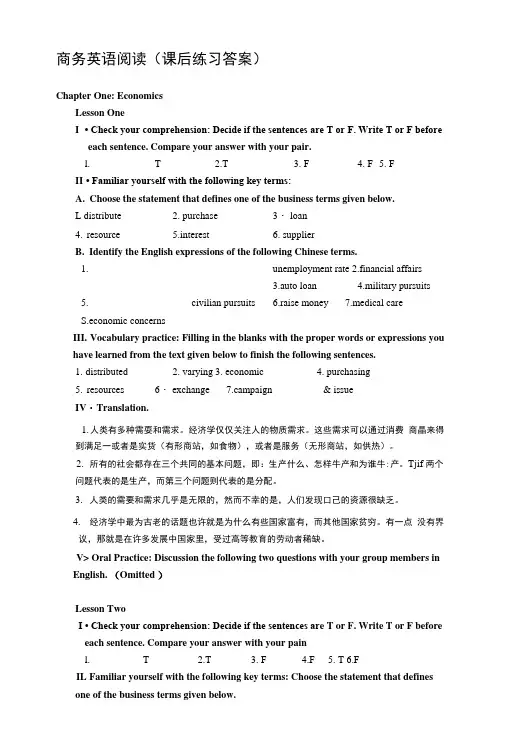
商务英语阅读(课后练习答案)Chapter One: EconomicsLesson OneI• Check your comprehension: Decide if the sentences are T or F. Write T or F before each sentence. Compare your answer with your pair.l.T 2.T 3. F 4. F 5. FII• Familiar yourself with the following key terms:A.Choose the statement that defines one of the business terms given below.L distribute 2. purchase 3・ loan4.resource5.interest6. supplierB.Identify the English expressions of the following Chinese terms.1.unemployment rate2.financial affairs3.auto loanitary pursuits5.civilian pursuits6.raise money7.medical careS.economic concernsIII.Vocabulary practice: Filling in the blanks with the proper words or expressions you have learned from the text given below to finish the following sentences.1.distributed2. varying3. economic4. purchasing5.resources 6・ exchange 7.campaign & issueIV・ Translation.1.人类有多种需耍和需求。
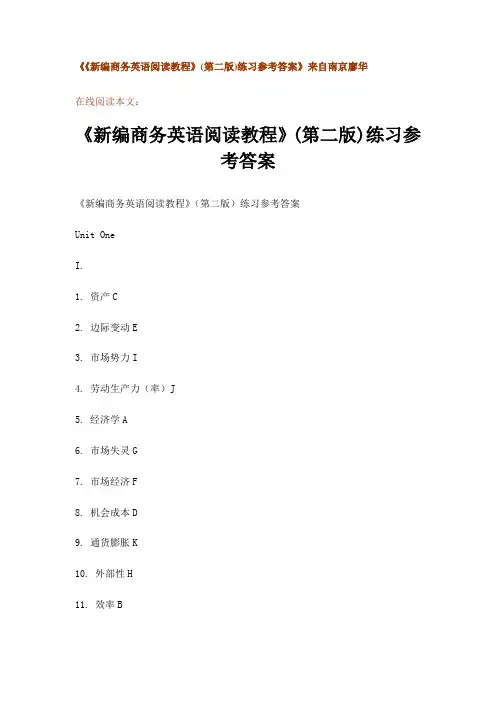
《《新编商务英语阅读教程》(第二版)练习参考答案》来自南京廖华在线阅读本文:《新编商务英语阅读教程》(第二版)练习参考答案《新编商务英语阅读教程》(第二版)练习参考答案Unit OneI.1. 资产C2. 边际变动E3. 市场势力I4. 劳动生产力(率)J5. 经济学A6. 市场失灵G7. 市场经济F8. 机会成本D9. 通货膨胀K10. 外部性H11. 效率B12. 菲利普斯曲线LII.Passage One经济学的研究主要分为两部分:宏观经济学与微观经济学。
宏观经济学着眼于经济全局——一幅宏观的画面。
在宏观经济学中,我们研究国家的政策目标,例如充分就业、抑制通货膨胀、经济增长等,而不考虑个人或者单个团体的利益和行为。
对宏观经济学的关注是为了从总体上认识并改善经济的运行。
微观经济学则关注宏观画面中的细节。
在微观经济学中,我们着眼于实际构成宏观经济的个人、厂商和政府机构。
我们感兴趣的是这些独立经济单位的行为。
他们的目标何在?以有限资源实现目标的途径是什么?如何对各种激励和机会做出反应?宏观经济学主要关注,例如,总消费性支出对总产出、就业及物价的影响。
很少关注消费性支出及其决定因素的实际内涵。
相反,微观经济学关注的是个体消费者具体的支出决策及其影响因素(爱好、物价水平、收入状况)。
宏、微观经济学的区别还反映在关于企业投资的讨论中。
宏观经济学中,我们需要了解决定企业总投资率的因素以及这些投资对一国的总产出、就业及物价水平产生影响的路径。
而微观经济学中,我们关注的是各家企业关于生产率、生产要素的抉择以及具体物品的定价决策。
了解宏、微观经济学的区别并非难事。
在现实社会,宏观经济的表现有赖于微观行为,而微观行为又受宏观经济表现的影响。
因此,人们只有了解了所有经济活动的参与者的行为方式及其成因,才能充分了解整个经济的运作方式。
但是,就如你会开车而不懂发动机的构造原理那样,你能观察到经济运行方式但并不能完全解开其中奥秘。
Unit 12Global M&AExercises1.Answer the questions on the text.1)What does the author expect M&A activity to be in 2011?The author expects that M&A activity will continue to growth in number and strength with the global economic recovery and the improvement of financial and credit market conditions.2)What must companies also consider about M&A besides favorable factorslike abundant cash and improving economic conditions?Companies must also consider the recent opposition to certain M&A deals by activists and some shareholders and their preference to other strategies.3)What do you think unsolicited transactions, hostile acquisitions and dealjumpings are in common?Passivity on the target company and out of its expectation.4)What may further encourage unsolicited transactions?Recent success of hostile acquirers in forcing target companies to negotiate and accept deals though occasionally taking a long time.5)What are the features and trends of private equity firms?They are seeking an exit from portfolio companies and are seeing M&A as an increasingly attractive alternative to capital market transactions.6)What is an tender offer?It is a public, open offer or invitation by a prospective acquirer to all stockholders of a publicly traded corporation (the target corporation) to purchase some or all of their shares. The price offered is usually at a premium to the market price. In a tender offer, the bidder contacts shareholders directly; so the directors of the company may or may not have endorsed the tender offer proposal.7)What are the key deal issues in M&A transactions?(1)reverse break-up fees(2)caps on damages payable by acquirers failing to close(3)the availability of specific performance remedies to compel a party tocomplete an acquisition8)How do US and UK takeover systems differ?In US takeover system, state case law allows target boards to take defensive measures within certain limits.In order to correct the perceived imbalance, UK disallows deal protection mechanisms; sets a default period in which a bidder will have to either announcea fully financed bid or walk away; and implements other measures to enhancebid-related disclosure.9)What are the views on the burden of extending bids into the U.S?(1)Some of both European regulators and bidders fear that the extension of paperbids into the US may be too burdensome and the exposure to the US plaintiffs’ bar and US courts may be too uncertain and risky.(2)But the case of Morrison v. NBA may have changed European regulators andbidders view because the pending anti-fraud-based actions against non-US companies were either dismissed or the damages to companies ere greatly reduced(3)The convergence between European and US securities regulations haveproduced positive effects, may further alleviate such concerns, and would encourage M&A players to consider using more shares in cross-border deals.10)How is M&A in emerging market expected to develop in 2011?(1)It is expected to grow over one-third in 2011, taking a larger share of globalM&A activity, particularly true in BRIC nations.(2)Sovereign wealth funds abundant in funds will continue to play a key role ininbound M&As and, meanwhile, private equity is to be much more important source of funds for M&A activities there.(3)Companies from emerging markets will engage in more outbound M&A dealsfor natural resources and market growth as well as inbound ones.(4)Multinationals from the developed countries may also go on M&A activitiesin emerging markets either for market footholds or growth opportunities. 11) What is said about US M&A deal enforcement?(1) The official agencies FTC and DOJ have continued to pledge vigorousmerger enforcement and have dedicated significant resources to updating themerger review process.(2) They have also proposed changes to pre-merger notification form.(3) The Antitrust Division has enhanced enforcement in vertical mergers as wellas horizontal mergers.12) What are the trends of EU antitrust enforcement?DG COMP and its Chief Economist team are paying close attention to the US-led debate over the need to define marketsDG COMP has increased its reliance on the counterfactual analyses for judging whether a merger prevents effective competition.2.Fill in each blank in the following sentences with one of the phrases in the listgiven below. Make changes when necessary.1)BRIC nations would support the country in the areas of education, health andagriculture, among others.2)In the second quarter we successfully secured a non-dilutive source of growthcapital on very favorable terms sufficient to drive both near and longer-term initiatives.3)We seem to value time in cyclical phases and seasons rather than in minutes andhours.4)The world is facing far more challenges than before in the context of intensifiedglobalization.5)In the debate Team A seemed to get upper hand at the beginning but quickly loststrength.6)He would discuss with the officials of Bulgaria various topics such as investmentclimate, the fight against corruption, and its accession to the European Union. 7)We are urging local education and city leaders to ramp up the pressure on theirgovernments to cough up more cash for new schools in their areas.8)Potential mayoral candidates are already flush with funds from their supporterfor the coming election.9)The government has been urged to follow through on its pledge to reform thecurrent wage system.10)The birth of a new nation in Sudan may give rise to numerous thorny issues,including sharing of resources.3.Match the terms in column A with the definitions in column B.A____________________ B__________________________________________ 1) equity market A) An asset class consisting of equity securities foroperating companies that are not publicly traded on astock exchange, including venture capital, growthcapital and mezzanine capital. 52) antitrust agency B) The market, also known as stock market, whereshares are issued and traded, either through exchangesor over-the-counter markets. 13) synergy C) A merger occurring between companies producingthe same or similar products or offering similarservices. 84) due diligence D) An organization responsible for prohibitingpractices that restrain competition, includingprice-fixing conspiracies and acts designed toachieve monopoly power. 25) private equity E) A company in which a venture capital firm, buyoutfirm, holding company, or other investment fundsinvests. 106) vertical merger F) A market in which individuals and institutionstrade financial securities in order to raise funds. 9 7) tender offer G) Additional effectiveness achieved from mutuallyadvantageous integration or compatibility of effortsor resources between business participants. 38) horizontal merger H) An investigation of a business prior to signing acontract, for example, a potential acquirer evaluatinga target company or its assets for acquisition. 49) capital market I) A public, open offer by a prospective acquirer to apublicly traded corporation to tender its stock forsale at a specified price during a specified time. 710) portfolio company L) A merger between two companies producingdifferent goods or components for the finalfinished product, for example, a car manufacturermerging a tire company. 64.Translate the following passage into Chinese.去年,由于全球兼并业务突破了网络泡沫时代的惊人水平,市场又跟1999年那样派对聚会。
Unit 9Beyond Bretton Woods 2Exercises1.Answer the questions on the text:1)According to the article, what is the essence of “quantitative easing” restartedby the FedPrinting money to buy government bonds.2)Why is no one satisfied with today’s international monetary systemBecause:Reason 1: D ominance of the dollar as a reserve currency and America’s management of it fail to reflect the realities of the world economy and leave others vulnerable to America’s domestic monetary policy.Reason 2: The system has fostered the creation of vast foreign-exchange reserves, particularly by emerging economies, thus poor countries lend to rich ones and lose investment opportunities.Reason 3: Scale and volatility of capital flow render unsteadiness for emerging economies.3)What is “trilemma” according to the textThe independence of domestic monetary policies, stability of exchange rate and perfect capital mobility can’t be realized at the same time. One must give up one factor to uphold the other two.4)What is the reason for a freer capital flow in these daysGlobalization as much as to the removal of restrictions.5)Why are countries unwilling to have their currency exchange rate to rise greatlyand how do they control itBecause abrupt rise in exchange rate would cripple export and countries want an undervalued currency to encourage export-led growth, so they buy foreign exchange to stem the rise.6)How is “Bretton Woods 2”created, according to the authorEmerging economies are coping the behavior of China, keeping their exchange rate at a low level so as to maintain their international competitiveness, thus they have to be tied to US dollars. This phenomenon then results in Bretton Woods 2.7)What is “Triffin dilemma”The conflict between the benefits and costs of a country with a reserve currency running a large current account deficit. The reserve-currency country enjoys the consumption benefit of running a trade deficit, while the rest of the world benefits from the additional liquidity, which helps facilitate trade. The cost comes from the declining value and credibility of any currency which runs a persistent trade deficit - eventually leading to a reluctance of creditors to holdthe reserve currency.8)Why can’t SDRs become a central reserve assetBecause as Mr Eichengreen w rites: “No global government… means no global central bank, which means no global currency.9)According to the text, what is the measure that the G20 could possibly take torebalance world economyIt can develop a plan with target ranges for current-account balances and real exchange rates and make it supported by peer pressure rather than explicit sanctions.10)What can be inferred from the title “Beyond Bretton Woods 2” in relation tothe world economyThere are probably two results of the world economy:One is that i f America’s economy recovers and its medium-term fiscal outlook improves, the pace at which capital shifts to the emerging world will slow. And if China makes its currency more flexible and its capital account more open in good time, the international monetary system will be better able to cope with continued financial globalisation and a wide growth gap between rich and emerging markets.The other is that if the world’s biggest economy stagnates and the second-biggest does not change its monetary policy, a rigid monetary system will eventually buckle.)2. Fill in each blank of the following sentences with one of the phrases in the list given below:1)The latest statistics indicate that this region’s economic recovery is tied to highereducation.2)According to financial news, this nation’s currency will appreciate against euro inreal terms.3)The couple described their narrow escape from the earthquake in New Zealandas they were inside the church when it began to fall apart.4)If you never take initiative to make it happen, this scheme is only something onpaper.5)At times of critical moment, one must subordinate passions to reasoning toavoid any possible blunders.6)Over two million migrant workers flooded into Beijing last year from all parts ofChina to seek potential opportunities for personal development.7)Thousands of city school teachers stand to lose their jobs under a tough budgetthat is set to unveil this coming Thursday.8)The car dealer guarantees that if customer is unhappy with the model hepurchases, whether on a bill of sale or hire purchase, he can totally swap it for a new one.9)Authorities in Zimbabwe have issued a new mega bank note in an attempt tocope with the troubled African country's runaway inflation.10)Economists use the term liquidity to describe the ease with which an asset canbe converted into the economy's medium of exchange.3. Match the terms in column A with the explanations in column B:A B1) reserve currency a) Ability of money to move across nationalboundaries freely in pursuit of higherreturns. 42) treasury bond b) A government monetary policyoccasionally used to increase the moneysupply by buying governmentsecurities or other securities from themarket. 73) currency war c) The actions of a central bank, currencyboard or other regulatory committee thatdetermine the size and rate of growth of themoney supply. 54) capital mobility d) A mechanism used by central banks to providefinancial institutions withaccess to funds tosatisfy reserve requirements and to increaseliquidity over longer periods. 85) monetary policy e) A currency held by many governments and aspart of their foreign exchange reserves andalso used as the international pricingcurrency for products traded on a globalmarket. 16) Special Drawing Right (SDR) f) A condition in international affairs wherecountries compete against each other toachieve a relatively low exchange rate for theirhome currency. 37) quantitative easing g) A marketable, fixed-interest U.S. governmentdebt security with a maturity ofmore than10years. 28) lending facility h) A period of time in which loans are lent by thegovernment and banks in an unrestrained way .99) credit binge i) A situation where a country's total import ofgoods, services and transfers are greater thanits total export of goods, services andtransfers..1010) current account deficit j) An international type of monetary reservecurrency created by the InternationalMonetary Fund and used as a supplement tothe existing reserves of member countries.. 64.Translate the following into Chinese:如果国际组织间举行一场全球性的声望比赛,国际货币基金组织毫无疑问会是最后一名。
商务英语阅读第二版王关富unit 1 Why China WorksUnit 1Why China WorksExercises1. Answer the questions on the text:1) How does the author view the Chinese economy?It is the most important bright spot in the world economy under the global recession, the only major economy that is likely to show significant growth this year, and the only one that routinely breaks every rule in the economic textbook.2) According to the author, why can the Chinese economy perform so well? Because of:(1) the capacity for state control by the Chinese government.(2) its rejection of exotic financial innovations that are the melting core ofthe global credit crisis.(3) the integration of its economic policies between traditional market toolsand state control measures.3) In what way does the author imply that western economists are erroneous in their bias toward “China’s market economic system”?The United States and Europe are moving toward state control by nationalizing their banking and car industries, and imposing heavy new regulation on the financial industry.4) What is the view of Stephen Roach on the Chinese economy system?Investment is the backbone of sustainable growth in the Chinese economy, which works more effectively than other market based systems in times of economic stress.5) Why can China work in the eye of the author?It has followed a radical pragmatism focusing on a slow but steady shift toward freer markets.6) What is regarded as the strategic thinking of the Chinese leaders in market reforms?They understand even under the serious financial crisis that it can stabilize the Chinese market and economy to introduce more sophisticated forms of securitization, including stock index funds, corporate bonds and other debt products. They also realize that, in the course of doing this, they should learn from the mistakes the westerners have made.7) What is the example given to illustrate the steadiness of the Chinese leaders in their policy execution?They continue to allow the value of yuan to rise despite of the American charges and the need for export competitiveness by their own enterprises.8) What is “shock therapy”?It is the economic policy adopted in Russia from 1991 to 1992 that totally deregulated prices and lead to a runaway inflation. It proved to be all shock and no therapy.9) In what ways does the Chinese economic system work efficiently?It can get things done quickly, move in a coherent manner, and marshal its people and resources to a common target: economic growth and prosperity. 11) What are the Internet and public opinion used for?For putting pressure on local officials and influencing policy decisions.2. Fill in each blank of the following sentences with one of the phrases in the list given below. Make changes when necessary.1)At a time when the need is growing for mental health services, manycountries are unfortunately cutting back on its spending.2)There is an increasing number of people out of work. But the western mediaoften unfairly label them as lazy and reliable.3)Now that the flow of oil has been stopped by BP, the impact of all the spilledoil and natural gas is still being measured.4)Once again its ability to steer economic policy will be tested against theability to deliver on services and projects aimed at growing the economy and jobs.5)Housing prices are incredibly high today. But he bought his house for a songabout five years ago.6)As people are complaining high prices, especially those related to dailynecessities, the government feels rather urgent to hold down inflation rate immediately.7)Under the new economy policy investors are invited to buy into state-ownedenterprises.8)Since a serious gun shooting occurred in Arizona last week, securityconcerns have trickled down to all places, including residential buildings. 9)Social unrest is a daily occurrence in the country nowadays. It is in the lastplace when it comes to investment for multinational companies.10)Efforts to ban smoking in China are so effective yet. Some chain smokersnever think of quitting while many others have battled in vain to quit.3. Match the terms in column A with the definitions in column B:A_______________________ B__________________________________1)financial innovation A) A reduction in the general availability ofloans (orcredit) or a sudden tightening of the conditionsrequired to obtain a loan from the banks.72)stimulus package B) A non-bank entity or organization such asinvestment companies and mutual funds thatinvests in large quantities. 83)overheating C)A legal entity created by a government toundertakecommercial activities on its behalf. 64)stamp tax D) The trading of a corporation's stock or othersecurities (e.g. bonds or stock options) byindividuals with potential access to non-publicinformation.9E) An industry thatrequires largeamounts of capital,machinery andequipment toproduce goods. 5 5)capital-intensive sector F) Generation of new and creative approaches tosecurities, money management or investing. 1 6)state-run firm G) An economy that is expanding so rapidly thattoomuch money is chasing too few goods andeconomists fear a rise in inflation . 37)credit crisis H) tax levied on certain legal transactions such asthetransfer of a property such as building, copyright,land, patent, and securities. 48)institutional investor I) A plan or a series of measures taken by agovernment to jump-start its ailing economy,generally as a part of its fiscal policy. 210) insider trading4. Translate the following passage into Chinese.我们所面临的来自中国的真正挑战并不是他们向我们大量销售的货物,而恰恰相反,是他们正在提升的价值链。
商务英语阅读(第二版)-王关富-Unit-6-Goodbye--Free-Trade 课后答案-
Unit 6 Goodbye, Free Trade? Exercises 1. Answer the questions on the text. 1) What was the result when the House of Representatives passed the Hawley-Smoot Tariff Act in 1930? The economic recession in the United States became even worse. 2) According to the author, what happens when a currency appreciates? It diminishes the export advantage of the country and makes it difficult to increase exports or even maintain the status quo. 3) How did American politicians take advantage of the public's strong anti-free-trade sentiment in the United States? They created a talking point in charges of unfair trade so that they thought they could benefit in the mid-term elections. 4) What did American politicians and economists agree and disagree over the Hawley-Smoot Tariff Act? Almost all of them agreed that it was a bad law, but they disagreed whether it triggered the Great Depression in the 1930s. 5) What did Milton Friedman think were the more important reasons for the Great Depression? The malfunctioning gold standard system and inept monetary policy of the Federal Reserve. 6) What was the foreign reaction unexpected by the American lawmakers after the Hawley-Smoot Tariff Act was enacted? The trading partners were angered and imposed discriminatory tariffs on American goods. Canada in particular, as the largest export market for the US, reacted fiercely and handed its market over to the British competitors. 7) Why is it unlikely for the US to adopt another Smoot-Hawley today in the eye of the author? (1) The US is much more integrated into the world economy today than it was in the 1930s. (2) Import restrictions seldom achieve their intended goals, instead, often end up hurting American industries and consumers. (3) The Americans have learned to consider the possible strong foreign retaliation against US exporters. 8) What were the respective results for those countries withdrawing from the the to according 1930s the during it to clinging those and standard gold
author? to gold standard allowed their currencies Those countries going off the monetary policies and, instead, used depreciate, avoided protectionist trade policy to end price deflation and stimulate economic growth. by policies protectionist trade countries Those choosing to stay on pursued imposing high tariffs, import quotas and exchange controls, which did little economic a longer Thus in boosting their economic growth. they suffered depression. quantitative of the author justify his support for policy How 9) does the easing? (1) Historically, the most important tool for resisting protectionist sentiment in the 1930s was a monetary policy that would promote economic growth. can right similar situation. Taking monetary policy the Today US is in a alleviate the pressure on Washington to adopt protectionist trade policy and can help to raise output before it leads to a high inflation. by said: Additional measures taken also (2) He quotes what Charles Evens the Fed to stimulate growth should condoned, not condemned. (3) What Mr. Friedman wrote 1997 about Japan: The surest road to a healthy economic recovery is to increase the rate of monetary growth, to shift from tight money to easier money. 10) What does the author imply about the US Congress? trade a following with the Fed, the US Congress is comparison In protectionist policy in blaming other countries for its unemployment and may cause serious trade retaliations from trading partners. 2. Fill in each blank of the following sentences with one of the phrases in the list given below. Make changes when necessary. As the financial scandal involves so many people, the probe in to it could 1drag on for another year. In the age of globalization more individuals are forced to integrate into 2)multinational work teams. Many in Europe are now very much worried that it may sink into a 3)Japan-style economic recession. But the business leaders yesterday warned against interest rate rises, arguing 4) that inflation was being driven not by consumer spending, but by rising commodity prices. 5) After the call scandal, the American automakers and some politicians there were so eager to keep their rival Toyota at bay in the auto market. 6) Under the current labor law, two categories of employees are exempt from
minimum wage and overtime requirements. 7) Though the local partner made a revised offer, the foreigner investor refused and reverted back to the original agreement conditions. 8) Last Friday the two parties met for more than five hours only to end up walking away from the table once again, reaching no agreement at all.